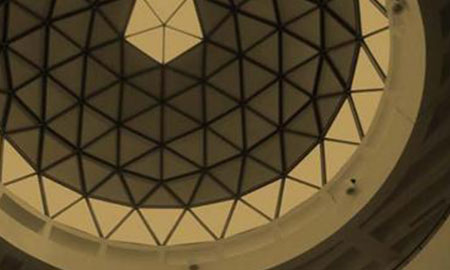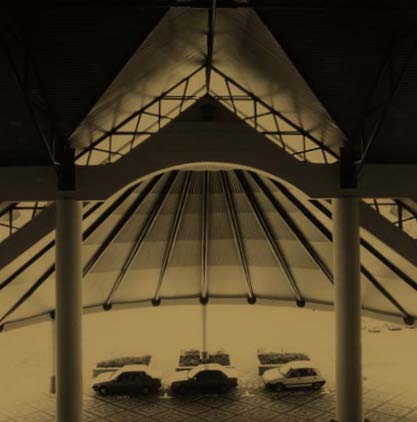
Often time, the architecture of a school building forms an integral part of the cherished memories of a student. Raffles alumni have studied in many different campuses-from the colonial designs of the Bras Basah building to the modern and homely design of the current Bishan campus. Get to know the reasons for the design and architecture of the Bishan campus which is eighteen hectares big in this two part feature article, and then come down to the school for a visit. Do drop us an email first though!
***
Take a walk from the campus of Year 1-4 to that of Year 5-6, and you will experience a comfortable, shaded and seamless connection between the two - no need to cross a road or walk under the hot sun. Along the way, you may see RI students walking to lectures or tutorials, gathering around a table for a conversation, reading quietly by a pond, playing with a frisbee or rehearsing for a performance at the amphitheatre.
When RI and RJC were integrated in 2009, one important objective was to create a space that would encourage interaction and bonding between the two schools.
Today, the campus infrastructure has fulfilled this cherished goal.
But the story behind the architecture of RI reveals that things did not start out this way. To begin with, the buildings of the Year 1-4 campus were not even originally designed for RI. 'The campus was meant for a yet-to-be named junior college on the Bishan site,' reveals Mr John Ting, Principal Consultant Architect at A.I.M & Associates and former president of the Singapore Institute of Architects. Mr Ting's winning design was selected from some 180 entries submitted to a national architectural design competition in 1987, organised by the then Public Works Department on behalf of MOE, as part of an effort to develop junior colleges with strong identities.
For students, first and foremost
Mr Ting centred his entire design philosophy on the primary user of the space: the student. 'We turned the pyramid upside down. We are saying with our design that a school should not be centrally planned, organised and managed - and the kids just come in to be educated. Our challenge was to design a place where the ecosystem looks at the student first and then the other groups who come together to educate, nurture and cultivate the student.' This approach guided the design of the entire campus.
For Mr Ting, the three-storey high atrium epitomises the student-centred philosophy. 'This is a place where students congregate, converse and commune, or simply pass through between classes and hang out after school,' he says.
The atrium was crowned with Singapore's first and only true geodesic dome. It was later coated through an electrolysis process with RI's school colours of green, black and white.
'To me, beauty in design is manifested in two forms: music and mathematics. That is because both can be so precise,' says Mr Ting.
'There is a rhythm in everything - from the size and composition of the equilateral glass triangles, to the size, colour, texture and tartan patterns created by the combination of ceramic tiles, granolithic finishes and granite tiles. People may not notice this overtly, but the consistency and integrity of design creates harmony.' Mr Ting had also hoped that his design would teach students about geometry.
The stained-glass clerestory1 panes under the portico of the Yusof Ishak Block are also educational in design. The west-facing façade, lit and animated by the afternoon sun, illuminates the concourse floor with the brilliant colours of the stained glass. 'If you sit in that space for a period of time, you will see the reflected image formed by the RI colours move across the floor, along with the sun. When the earth rotates, the sun's angle incident on the earth changes continuously and the light cast on the stained glass changes position. From this, students can learn about geography and physics,' explains Mr Ting.

The stained-glass clerestory panes under the portico.
As fate would have it, this student-centred campus design proved apropos for the premier and oldest school in Singapore.
The grand entrance became an ideal location to place the bust of its founder, Sir Stamford Raffles.
The circular parapet wall of the atrium also provided a perfect gallery for displaying the pictures of past headmasters. With these features, Mr Ting and his team successfully provided a canvas onwhich RI's identity and soul could be captured.
Architecture attuned to the environment
Even before the Building and Construction Authority began promoting green buildings in the mid-2000s, Mr Ting and his team were designing the school with the environment in mind. They drew inspiration from buildings of old. 'With our harsh tropical climate - hot weather and heavy rain - it was clear that the building would need ample cool, shaded areas so students wouldn't get wet when they move around the school. The older school buildings built by the British, like RI's Bras Basah campus, came to mind because they were climatically more responsive. Newer schools have flat roofs, which are atropical in nature,' says Mr Ting. Thus, coincidentally learning and drawing similarities from RI's old buildings, the new buildings at Bishan were fringed with steep terracotta-tiled roofs, shaded wide external corridors, and open spaces where air convection can form naturally and air can flow freely to cool the buildings.
Mr Ting's team also chose to design tiled roofs because they provide better insulation. Every classroom would be well-ventilated, with full-length windows on one side and high-level grilles on the other. 'Sunlight can flood the entire room, but it is not glaring because the brise soleil shades it,' explains Mr Ting. Brise soleil is the deep-seated egg-crate sun-shading structure which acts as a secondary layer outside the window wall.
It cuts down the penetration of sunlight, resulting in soft and diffused lighting in the room.
Becoming RI
It wasn't till halfway through the construction of these buildings for the unnamed junior college, that it was made known to Mr Ting and his team that the school would become the new home of RI. The team had to go back to the drawing board to design additional classrooms to accommodate the growing needs of a secondary school that was about to go independent. They borrowed from the ideas of Louis Kahn, a prominent American architect who developed the concept of 'master' and 'servant' spaces, or main and supporting blocks, and applied this theme to general campus planning, the composition of the blocks and even the details of the interior architecture of each block.
Mr Ting and his team were thus able to provide more useable space in the Marshall Block within the given land plot and budget for the additional classroom block.
'In the end we saved 20 per cent of circulation space,' Mr Ting says proudly.
In addition, the Marshall Block was to become the Arts Hub.
To provide space for students to display their artworks without having to carve out a separate gallery space, Mr Ting cleverly adopted the concept used at New York's Guggenheim Museum, designed by Frank Lloyd Wright, where one can view artworks displayed along the walls outside the classrooms from all levels of the block.
The team also tried their best to personalise the school for RI: the founding year of RI, 1823, can be found on the entrance archway as well as on the façade facing the original assembly area; the bust of Raffles was placed in the atrium of the Yusof Ishak Block; and the school emblem graced the wall of the atrium facing the entrance. Some old bricks from the school at Bras Basah were also used to build a wall close to the entranceway to the Yusof Ishak Block.
In his original design, Mr Ting also made provisions for growth and expansion should the school need them. 'We call them "soft spaces",' says Mr Ting. They give allowance for the school to grow as its needs grow; they are upgraded and transformed in tandem with time and needs. RI moved into the Bishan campus in 1990. In 1996, a Boarding Complex, Junior Block (now known as Sheares Block) and Shaw Foundation Hall were opened to cater to the growing needs of the school.

Now that you’ve understood the rationale behind the design of the Year 1-4 Campus, find out how the Year 5-6 Campus was integrated with the Year 1-4 Campus to provide a seamless flow from one end of the school to the other. Here is part two of our feature article on the architecture of the school. Do drop us an email if you are interested to come down for a tour of a school.
***
A new RJC
In 1999, plans were underway for the plot of land on the other end of the Bishan site to be developed for the then RJC. The design team, led by Mr Tan Chee Wee, Director, Design, CPG Consultants Pte Ltd - then known as PWD Consultants -was given the task of designing a campus that would not only support the junior college's programmes, but also create a vibrant learning environment that would encourage cohort bonding with RI.
'Initially we were exploring the idea of having a sports hub or a common playing field between the two schools to draw the RI and RJC students together.
However, due to the irregular configuration of the site, that possibility was quickly ruled out,' Mr Tan says. The idea of cohort bonding through the integration of academic facilities was mooted and this led to the creation of the 'learning spine', which would provide a seamless connection to RI.
After studying the original 5.9-hectare site closely, a seven storey medium-rise block was designed along the learning spine or central axis. The central axis traversed the full length of the site to act as a circulation spine and connect the various blocks that housed teaching and functional facilities such as the lecture theatres, tutorial rooms and science labs. This linear connector was designed as a double-storey level, so that students can travel between the Year 1-4 and 5-6 campuses in a safer environment.
Another advantage of this spine is that it makes the upper floors very accessible to the students.
'We deliberately sited the lecture theatre on the second storey, and it is accessible from both the second and the third storeys.
We are effectively reducing the students' travelling time,' explains Mr Tan. This prevents a loss of curriculum time.
The team created in-between spaces as informal study spaces to encourage opportunities for peer and group learning. An amphitheatre was also designed as a focal point along this learning spine so that students from both institutions can interact and bond.
As Mr Tan, whose son is currently studying in RI, walked with us along this thoroughfare, he was very glad to see that the space was heavily utilised. 'I see students using it for their performance rehearsals, frisbee games or just to relax and chat. It is a vibrant social space.' Six months into the construction of the RJC campus, the design team was told that the Ministry of Education had approved the implementation of the Raffles Integrated Programme. This meant that the population of RJC students would increase and the campus had to expand correspondingly.
Like the team for the Year 1-4 campus, Mr Tan and his team had to go back to the drawing board.
An additional 2.7 hectares of land were amalgamated with the original RJC site.
The revised master plan included four additional new blocks and a repositioned sports field. The learning spine - which previously terminated in a dramatic circular foyer space forming the entrance lobby of the college library and administrative block - would be extended in a southwest direction from the entrance foyer to the multi-purpose hall.
The circular block H, as the heart of the complex, was singled out and treated as a main building.
It was placed at the intersection position and integrated with a quadrangle to act as a focal point.
Students have nicknamed the steps leading from the quadrangle to the main building the 'watermelon steps', as they are painted in Rafflesian green, black and white.
The main building is flanked by two identical blocks - the Performing Arts Centre and Indoor Sports Hall - in a fanned-out layout. The extension also made it possible to include a running track with a viewing gallery, as the location of the track was moved to the end of the axis.
Another boon from the extension of the axis was the Shaw Foundation Library. Previously designed as part of the rectangular-shaped resource block, it would now occupy a much larger space in the main circular building. 'It created an opportunity for us to design a library that was unique,' recalls Mr Tan. The library has a wide reading space on the lowest floor with two surrounding floors of resources that create a stacked backdrop. Natural light breaks through between sections of bookshelves, giving visitors partial views of the greenery outside.
RJC moved into the new campus in 2004. Of all the challenges of building the school, what gave Tan and his colleagues the greatest satisfaction was completing the learning spine that joined the Year 1-4 campus with the Year 5-6 campus. 'We were given the opportunity to work on the Rajaratnam Block in 2006 to make the seamless connection to the Year 1-4 campus. We were finally able to realise what we had originally conceptualised,' says Mr Tan.
And so in the end, the twain did finally meet as the perfect plans unfolded for the Year 1-4 and Year 5-6 campuses, creating an architectural and spatial bond between students from both sides - and reuniting the school spirit as well.
© The above article was extracted from Eagle Eye Issue 7.